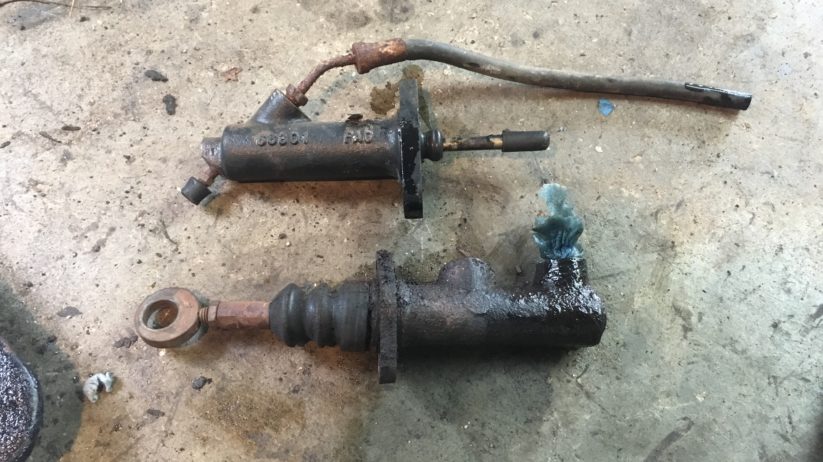As I wait for the logistics on the Lama (the E28 I just bought sight-unseen in Tampa) to settle, I’ve turned my gaze and wrenches back to Bertha in a final push of fall fixes.
A few weeks back, I wrote about “The End Game,” the list of repairs Bertha needed in order for me to feel that she was ready for a road trip, and there’s nothing like writing up a punch list to get you clocking through it.
I replaced the differential and was delighted to find that this solved a whine-and-rumble noise that I’d assumed was in the transmission. I bought a Pertronix electronic-ignition module and a spare electric fuel pump. But the biggest outstanding issue was the clutch hydraulics.
The clutch master, as far as I know, was original to the car. I’d replaced the clutch slave when I’d installed the five-speed, but that was probably in 1990; basically, the clutch hydraulics in Bertha had sat for 26 years. Given that, my experience told me that clutch hydraulic failure in Bertha was a near-certainty; it wasn’t a question of if, but when. So I ordered a new master and slave cylinder.
But with Bertha’s whine-and-rumble vanquished, with New England’s glorious September weather beckoning, and with the clutch stubbornly still working, I kept driving the car, albeit with the sword of Damocles dangling over its, uh, clutch. I was itchy for at least a mini-road-trip, so I took Bertha on a 15o-mile round-trip drive up to New Hampshire and back to look at a well-priced E30 325is. The drive was nearly all highway, so shifting was minimal, but when I did need to shift, I noticed that the clutch pedal occasionally felt a little floppy, with most of the action near the bottom.
Clearly, clutch-hydraulic replacement time was drawing nigh. The new master cylinder, however, hadn’t yet arrived.
A few days later, I received an e-mail from longtime Boston chapter member John Whetstone, inviting me to an informal event at the A&W Drive-In burger joint in Smithfield, Rhode Island. I thought that this sounded perfect for another mini-road-trip in Bertha.
John, who remembered Bertha from chapter events in the mid-’80s, was excited about my bringing the car. With signs that Bertha’s clutch hydraulics were teetering on the edge, I vacillated on taking her, but, as with the drive up to New Hampshire, I figured that the 100-ish-mile Rhode Island jaunt was mostly highway, and thought that this fact would minimize the risk of the clutch hydraulics failing en route. Plus, if need be, one can always start a car in gear, get it running, and shift by matching rpm as best one can. Bertha’s transmission already has a destroyed fourth-gear synchro; it’s not like I’d be risking a pristine gearbox.
The final part of my rationalization was that it was only Rhode Island; it’s not like I was heading off into the great dark unknown. If the car croaked, AAA or Hagerty Roadside Assistance could drag it back at minimal cost.
In the end, as Doc says in Back To The Future, “Sometimes you just have to say, what the hell.” So on a crisp September evening, off Bertha and I went to Rhode Island for a burger and some BMW love.
But on the drive down, I hit unexpected traffic. I had to row second to third to fourth endlessly. Each time, I imagined the clutch pedal dropping to the floor like a puppet whose strings had been cut.
Fortunately, the hydraulics soldiered on. I arrived at the A&W without incident, and had a great time. In addition to John Whetstone, other longtime Boston chapter members Joe Chamberlain, Mike Cinnamon, and Bruce Machon were there; it felt like old times. And Bertha was the center of attention, at least until Eric May arrived with his pristine 1970 Agave 2002, and a young man rolled in in a Polaris 850i six-speed with a black interior.

Bertha’s orange Recaro fabric and rusty-patina-soaked hood looked right at home in the orange motif of the A&W.
As the event was winding down, Bruce Machon said that a bunch of folks were going to a pub to hear a great local blues band, and asked me if I wanted to come with them. I demurred; I was about to explain that I’d tempted fate enough with Bertha’s clutch, but Bruce immediately said, in his deep Rhode Island baritone, “No, you’re coming!” Right, then, I thought I’m coming.
It was a longer-than-anticipated drive to get to the pub, adding maybe another twenty miles round-trip. When we arrived and I parallel-parked Bertha, the transmission went in and out of gear without crunching, but the clutch pedal definitely felt flaccid, requiring pumping to gain efficacy. I hoped I’d be able to pull her back out of the spot.
The band was great, but the evening and clutch-related anxiety began to catch up with me. I left the pub, fired Bertha up, pumped up the clutch pedal, made a wish, put her in gear, backed her up, pulled forward out of the spot, and drove home, shifting as infrequently as possible.
I made it with no issues.
I put Bertha in the garage, positioned her over the lift, and tucked the E9 in behind her. The next morning, the new clutch master cylinder arrived. All right, then, I thought; I’ve tempted fate long enough. Let’s get this done right now.
I went out to the garage and moved the E9 out of the way, then noticed that I’d parked Bertha the wrong way over the lift; I needed to turn her around so her nose was forward, giving the greatest amount of room to work with all the crap in the garage. I got in and hit the clutch—
And the pedal went right to the floor.
I pumped the pedal a few times, and it firmed up. I started the car, but when I tried to shift into gear, it just crunched. The clutch hydraulics had officially failed. Their replacement was no longer prophylactic.
I shut the car off, made sure there wasn’t anything behind it, put it in reverse, and started it. The car did that ungainly geHAWgeHAWgeHAW thing it does when you unintentionally start it in gear. The ignition soon caught, and I backed the car out of the driveway. Finally the pedal pumped up just enough for me to put it in first; rather than do a three-point turn, I drove the car around the block to turn it around. With a crunch, I got it in reverse again, backed it into the garage, and maneuvered into the proper position over the lift.
When I hit the clutch pedal to take it out of gear, the pedal went to the floor again. I eased the gearshift into neutral so that I wouldn’t run into the back wall of the garage.
Guess I got the maximum lifetime out of those hydraulics, huh?
As I said a few weeks ago, I’m comfortable throwing a spare electric fuel pump in the trunk and swapping it on the road if the 33-year-old one dies, but clutch hydraulics are best done in the comfort of your own garage. Most of the work is done under the car, so at a minimum, the car must be jacked up and securely supported. On a 2002 with a stock four-speed, the slave is mounted in a hole in the rim of the bell housing, held in place by two snap-rings that can be maddeningly challenging to remove, and even once you get them off, the steel slave can be rust-welded into the aluminum hole in the bell housing due to corrosion of dissimilar metals, requiring relentless heating-and-beating to get it out. These issues were all in play a year and a half ago when I had to deal with Louie’s clutch hydraulics in Louisville.
Fortunately, Bertha wasn’t as recalcitrant. She has a Getrag 245 five-speed on which the slave is bolted to the side. The upper slave nut requires a long extension and a wobble joint to reach it, but other than that, the slave is easy to replace.
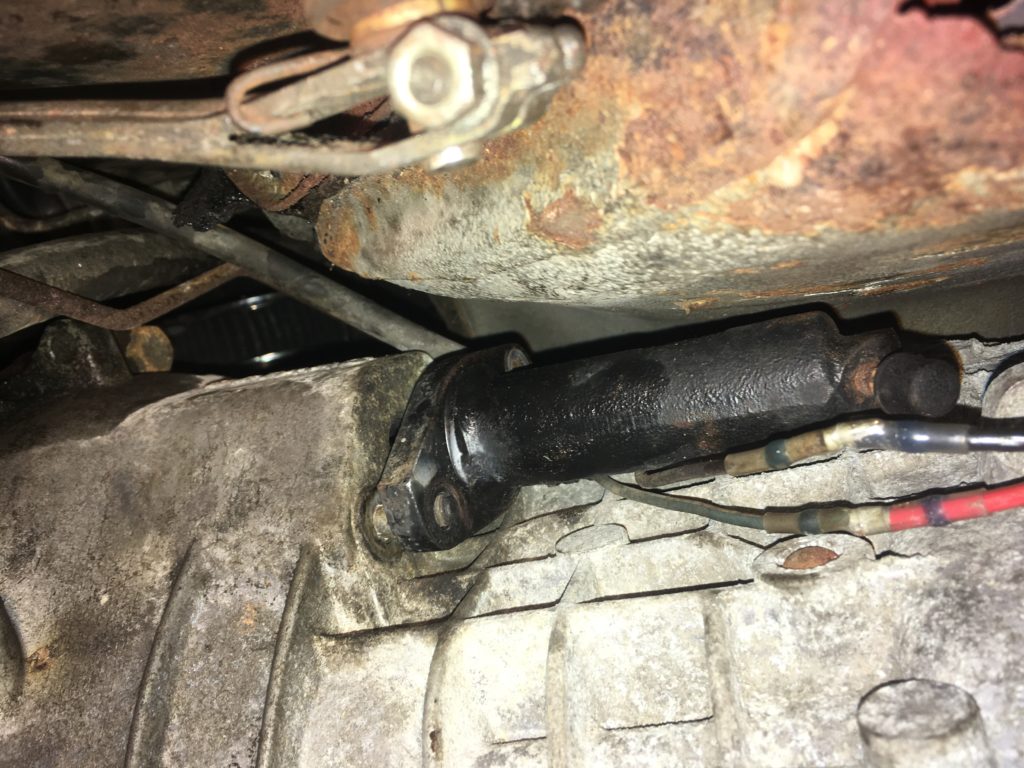
There’s not much clearance for the clutch slave cylinder on a 2002 five-speed, but it can be removed and installed without major headache.
To remove the master cylinder, you need to access it from the pedal bucket inside the car. This requires peeling back the rug. On a ’73 or earlier 2002 with a multi-piece rug, this is trivial, but on a big-bumpered car with a one-piece rug and air-conditioning, it can be a major pain, as part of the rug is usually trapped on the hump by the console and evaporator assembly. Fortunately, I’d anticipated this issue when I rebuilt the air-conditioning, and made certain not to screw the evaporator bracket into the rug.
When I unbolted the clutch pedal from the master cylinder, I found a small issue: The two nylon bushings on the pivot bolt were worn out. This explained the play and squeaking in the clutch pedal. I put a pair of bushings on order at my local BMW dealer ($1.74 each) and had them within a day.
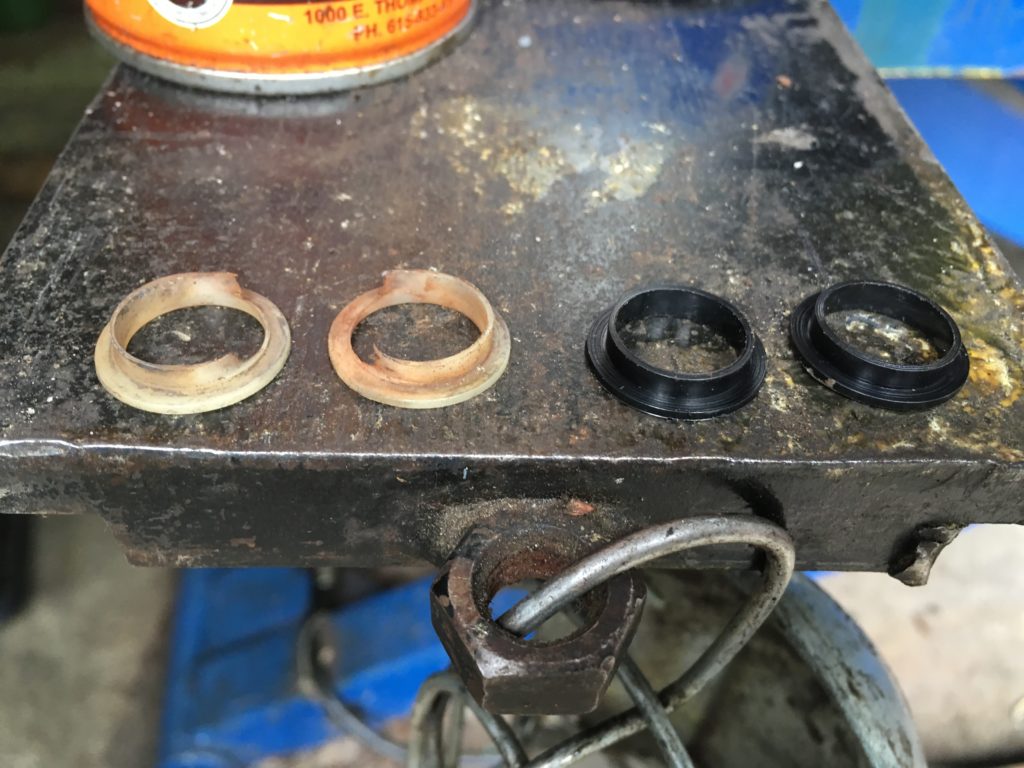
Here are the old and new clutch pivot bushings.
The clutch master cylinder itself is bolted through the pedal bucket, with two 13-mm bolt heads on the inside and two 13-mm nuts under the car. There are two challenges to removing these; the first is that someone, or something, has to hold the bolt heads while someone unscrews the nuts, or vice-versa. On the Louie adventure, that someone was my friend Dave Gerwig, who stuck with me through cold and darkness and held a flashlight and a wrench in Jake Metz’s then-unelectrified pole barn to help me change Louie’s clutch master when it failed as I was about to hit the highway home.
With Bertha safely moored in the comfort of my own garage, though, doing this without a helper was pretty straightforward; it merely involved positioning a wrench, or a socket and handle, so that when the nut or bolt was loosened from the other side, the wrench swung and caught on something solid. You could also hold the bolt in place with a set of Vise Grips.
The second issue is that the top nut on the master cylinder is difficult to turn or hold still. Due to clearance issues, you can’t get either a socket or a box-end wrench on it. Some folks use a short open-end wrench; I used the same crow-foot wrench I bought at Harbor Freight in Louisville to get the master cylinder off Louie. At that time, I held the crow-foot in place with a ratchet handle and extension while Dave loosened the bolt from inside the car, but on Bertha, I found that if I slipped the crow-foot over the top of the nut as pictured below, it rotated to the right and pinned itself in place when I loosened the bolt from inside the car.

The crow-foot wrench pinned itself in place and held the upper nut still while I loosened the bolt from inside the car.
I’ve read about how, prior to installation of a new clutch master, folks grind a little bit off the cylinder’s lip to get clearance for a socket or wrench, but I left it the way it was, and used the crow-foot again to hold the nut for installation.
The other thing you need to know about the clutch-master-cylindeer installation is that you need to seat the metal or plastic rigid line from the brake fluid reservoir into the rubber grommet in the master before you install the master in the car. This means disconnecting the line from the reservoir, holding it in one hand and the master in the other, and pushing and twisting the line into the grommet to seat it. You might think that you can do this with the master installed in the pedal bucket, but it is nearly impossible to get the proper angle and enough leverage.
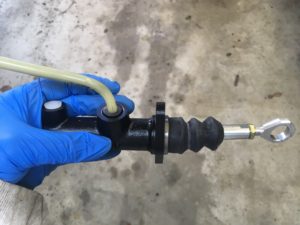
This shows the fluid line seated in the grommet.
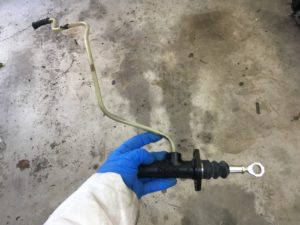
The line and master cylinder need to be installed together.
Once the line is seated, you then install the master and line together. You can do this from above (lowering the master in place) or below (snaking the rigid line upward). If you do it from above, the technique—and I’m going to quote Paul Wegweiser directly—is “lowering the master cylinder into place by the line as if you’re dangling a chicken neck to a bunch of snapping turtles.”
The only remaining issue was the flexible clutch hose that connects the master cylinder to the slave. Five-speeds need a longer hose than the stock four-speed. Bertha’s existing clutch hose was seized in both the slave and master; the corners of their 11-mm nuts rounded off even when I was using a flare-nut wrench after applying heat and wax.
Re-using the existing hose would’ve been false economy anyway. Several Roundel advertisers (Ireland, La Jolla, Rogers Tii) sell a purpose-built 2002 five-speed braided clutch hose with two male ends at the correct angles. I almost bought one, but then recalled that I had a braided stainless clutch line of some sort in the garage. I found it, saw that it had a female fitting at one end, ran down to Autozone to buy a short male-to-male metric bubble-fitting line to mate to it, bent the metal line to not interfere with the upper nut on the clutch slave, and installed it.
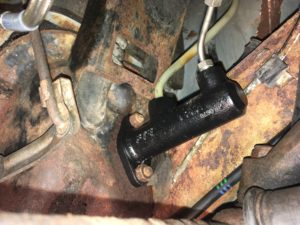
The newly-installed clutch master cylinder with both lines attached, and…

…the newly-installed slave with its metal line.
So the clutch hydraulics are done, and there are some crucial spares in Bertha’s trunk. I’d feel pretty comfortable venturing further from shore in her. But with October breathing down my neck, driving season is getting short. The odds are that Bertha won’t get a real road trip before she’s put away for the winter. However, I’m looking forward to letting her strut her stuff at the Nor’East 02ers picnic up at VSR1 Racing at the end of October.
And there’s one more surprise repair I’ll reveal, probably next week.—Rob Siegel
Rob’s new book, Just Needs a Recharge: The Hack MechanicTM Guide to Vintage Air Conditioning, is available here on Amazon. His previous book Ran When Parked is available here. Or you can order personally inscribed copies of all of his books through Rob’s website: www.robsiegel.com.

